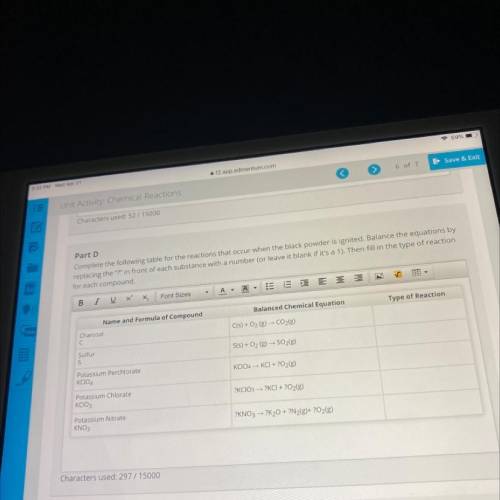
Chemistry, 21.04.2021 23:00 chanahvanya
Part D
Complete the following table for the reactions that occur when the black powder is ignited. Balance the equations by
replacing the "?" in front of each substance with a number (or leave it blank if it's a 1). Then fill in the type of reaction
for each compound.
B.
I X
X
Font Sizes
A-
A-
= = 三 三 三
A
Name and Formula of Compound
Balanced Chemical Equation
Type of Reaction
Charcoal
C
C(s) + O2 (g) - CO2(g)
Sulfur
S
S(s) + O2(g) → SO2(g)
Potassium Perchlorate
KCIO4
KCIO4 - KCI + O2(g)
Potassium Chlorate
KCIO3
?KCIO3 → ?KCI + 2O2(g)
Potassium Nitrate
KNO3
?KNO3 → ?K20 + ?N2(g)+ ?O2(g)
Characters used: 297/ 15000


Answers: 3
Another question on Chemistry

Chemistry, 22.06.2019 12:30
The melting point of sulfur is 115 °c and its boiling point is 445 °c. what state would sulfur be in at 200 °c?
Answers: 1


Chemistry, 22.06.2019 17:30
98 points you will be galileo perform the experiment to determine if objects with different mass fall at the same, or different, rates in the air and in a vacuum. before you conduct your experiment, you need to form a hypothesis. a hypothesis is a prediction of what you think will happen in the experiment. the hypothesis is a statement that describes “if” a certain set of circumstances are present “then” there will be a specific result that will occur. record your hypothesis here: record the results from step one of the experiment (dropping the objects in the air): first trial: second trial: third trial: record the results from step two of the experiment (dropping the objects in a vacuum): first trial: second trial: third trial: did the experiment support your hypothesis? using the data from your experiment, describe why you believe your hypothesis was either proven or disproven. what forces were acting on the objects dropped in the air? what force was acting on the objects dropped in the vacuum? part two: comparing forces choose two forces and compare and contrast these forces. you must provide two ways that they are alike and two ways that they are different. you may make a list, write in paragraph form, or make a chart. choose two forces and compare and contrast these forces. these must be different forces than used in the prior question. provide two ways that they are similar and two ways that they are different. you may make a list, write it out, or make a chart.
Answers: 3

Chemistry, 22.06.2019 19:30
Phosphorous can form an ion called phosphide, which has the formula p3−. this ion can form an ion called phosphide, which has the formula p3−. this ion properties very similar to those of pforms when a phosphorus atom loses three protonsis called a cationcontains 18 electrons
Answers: 2
You know the right answer?
Part D
Complete the following table for the reactions that occur when the black powder is ignited....
Questions

Mathematics, 16.10.2020 07:01

Physics, 16.10.2020 07:01

Mathematics, 16.10.2020 07:01

English, 16.10.2020 07:01





History, 16.10.2020 07:01

Mathematics, 16.10.2020 07:01

History, 16.10.2020 07:01

Mathematics, 16.10.2020 07:01


Social Studies, 16.10.2020 07:01


History, 16.10.2020 07:01

Mathematics, 16.10.2020 07:01


Biology, 16.10.2020 07:01



